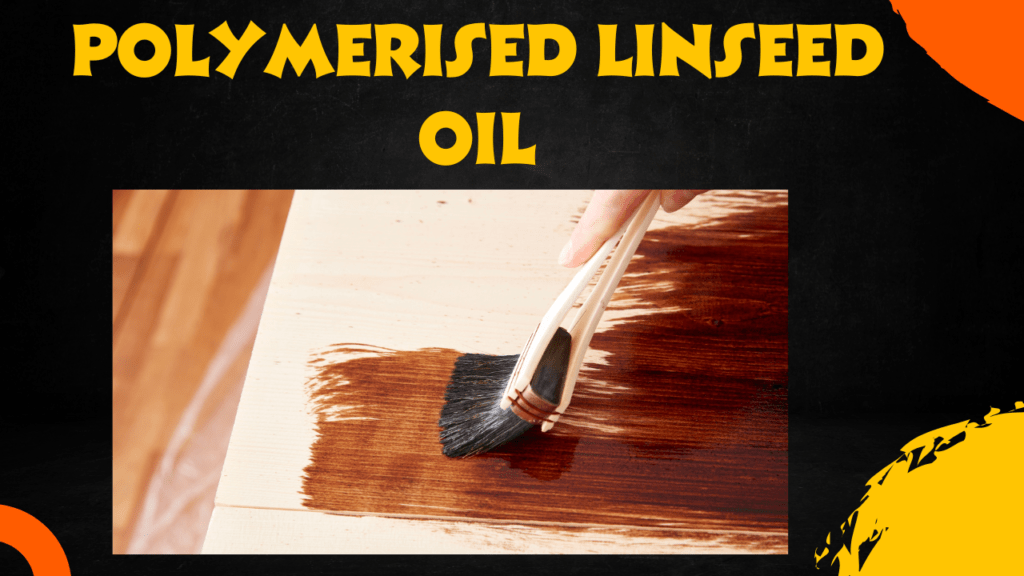
Polymerised linseed oil is becoming popular as a natural finish for wood. People value it because it is strong, safe for the environment, and makes wood look beautiful.
In this guide, you will learn what polymerised linseed oil is, how it is made, its benefits, common uses, and why it is a great choice for eco-friendly woodworking.
What Is Polymerised Linseed Oil?
Polymerised linseed oil is one of a special type of linseed oil. It is made from raw linseed oil, which comes from flax seeds. The raw oil is heated at about 300°C (572°F) for several days without oxygen. This heating process is called polymerization.
During polymerization, the oil molecules join together to form longer chains, which makes the oil thicker. This change helps the oil dry much faster than raw linseed oil. While raw linseed oil can take weeks to dry, polymerised linseed oil can cure in just 1 to 2 days.
Another big advantage is that it does not contain harmful chemicals or volatile organic compounds (VOCs). This makes it a safe, natural and a eco-friendly choice for wood finishing.
How Is Polymerised Linseed Oil Made?
The creation of polymerised linseed oil involves raw linseed oil being heated carefully in a sealed environment to prevent exposure to oxygen, which could cause the oil to oxidize prematurely or burn.
By maintaining an oxygen-free atmosphere during this prolonged heating, the oil undergoes a polymerization transformation.
This process thickens the oil naturally without the need for added chemical drying agents or solvents, unlike boiled linseed oil, which often contains metal salts or petroleum-based compounds to accelerate drying. The absence of harmful additives means polymerised linseed oil is safer for both users and the environment.
Advantages of Polymerised Linseed Oil
- Eco-Friendly and Safe: As a product free of VOCs and harmful heavy metals, polymerised linseed oil is considered food-safe and non-toxic once fully cured, making it an ideal finish for furniture, cutting boards, and children’s toys.
- Fast Drying: The polymerization significantly speeds up drying time to just 1-2 days depending on conditions, enabling quicker project completion compared to raw linseed oil, which can take 2 to 10 weeks to dry.
- Durable Finish: Polymerised linseed oil creates a strong, flexible coating that protects wood from scratches, water damage, and daily wear, helping the wood last longer.
- Natural Appearance: The finish brings out the wood’s natural grain and color without making it look too shiny or too dark, so the wood keeps its original, natural look.
- Deep Penetration: Like other linseed oils, it soaks deep into the wood, feeding it and protecting it from the inside.
- Versatile Use: Suitable for a variety of woodworking projects including indoor furniture, countertops, floors, and specialty wood items requiring a non-toxic finish.
Polymerised Linseed Oil vs Raw and Boiled Linseed Oil
| Feature | Raw Linseed Oil | Polymerised Linseed Oil | Boiled Linseed Oil (BLO) |
| Drying Time | 2–10 weeks | 1–2 days | 1–2 days |
| VOCs | None | None | Contains VOCs |
| Food-Safe | Yes | Yes | No |
| Additives Used | None | None | Drying agents (metal salts or solvents) |
| Finish Durability | Moderate | High | Moderate |
| Best Applications | Traditional finishes, non-rushed projects | Fast finishing, sustainable furniture | Quick projects, non-food surfaces |
| Environmental Impact | Low | Low | Higher due to drying agents |
This comparison highlights polymerised linseed oil as an excellent middle ground between raw and boiled linseed oils, combining fast drying and safety without harmful chemicals.
How to Apply Polymerised Linseed Oil on Wood
Proper application techniques ensure maximum protection and aesthetic appeal from polymerised linseed oil finishes:
- Surface Preparation: The wood should be clean, dry, and sanded smoothly with fine-grit sandpaper (220–320 grit). Remove all dust.
- First Coat Application: Using a clean cloth, brush, or applicator pad, apply a thin layer of polymerised linseed oil evenly along the wood grain.
- Penetration Time: Let the finish sit and soak for 15–30 minutes. If excess oil remains on the surface, wipe it off with a clean cloth to prevent sticky residue.
- Drying Time: Let the wood dry for about 24 hours in a warm, well-ventilated area.
- Additional Coats: Apply 2-3 coats for optimal protection, lightly sanding with extra-fine sandpaper (400–600 grit) between coats for smoothness.
- Final Cure: Although surface drying occurs fast, full curing for maximum hardness and durability can take up to one week, depending on environmental conditions.
Following these steps will result in a deep, durable finish that enhances the wood’s natural beauty without compromising its safety or sustainability.
Uses and Applications
Polymerised linseed oil is preferred in woodworking and furniture making because it gives good protection while being safe to use:
- Furniture: Protects and beautifies solid wood tables, chairs, cabinets, and more.
- Cutting Boards & Kitchenware: Its food-safe attributes once cured make it suitable for surfaces that contact food.
- Wood Floors: Adds moisture resistance and durability to hardwood flooring.
- Specialty Woodwork: Ideal for children’s toys, heirloom restoration, and antique preservation where non-toxic finishes are paramount.
- Crafts and Musical Instruments: Provides a flexible yet protective coating for hand-crafted wooden items.
Safety and Environmental Considerations
Unlike boiled linseed oil, polymerised linseed oil contains no heavy metals or volatile solvents, making it safer to work with indoors and around family. Properly stored polymerised linseed oil has a long shelf life and does not pose significant fire hazards. However, oily rags from any linseed oil products should always be handled carefully and disposed of safely to avoid spontaneous combustion risks.
From an environmental perspective, polymerised linseed oil is renewable and biodegradable, derived from flax plants, making it a sustainable finishing option for modern eco-conscious woodworkers.
Final Thoughts
Polymerised linseed oil stands out as an advanced natural wood finish combining the best traits of traditional raw linseed oil with improved drying times and durability—all without compromising safety or environmental responsibility.
It is especially well-suited for furniture makers, DIY enthusiasts, and anyone seeking a fast-drying, non-toxic, food-safe finish that enhances the wood’s natural beauty.
Those exploring wood finishes are encouraged to consider polymerised linseed oil as a superior choice for sustainable, long-lasting results. Whether restoring antiques or crafting new heirloom pieces, this finish respects the past while meeting today’s performance and safety expectations.
By understanding the unique properties, application methods, and benefits of polymerised linseed oil, woodworkers can select the right finish to showcase their craftsmanship and protect their work beautifully for years to come.
Frequently Asked Questions (FAQs)
1. Is polymerised linseed oil food-safe?
Yes, it is food-safe once fully cured because it contains no harmful additives or solvents, making it perfect for cutting boards and kitchen furniture.
2. How does polymerised linseed oil differ from boiled linseed oil?
Boiled linseed oil contains chemical drying agents and solvents, releasing VOCs and requiring safety precautions during use. Polymerised linseed oil is heated without chemicals, contains no VOCs, dries fast, and is safer for indoor and food-contact use.
3. How long does polymerised linseed oil take to dry?
Typically, it dries to touch within 24 hours and fully cures in about 1 week, much faster than raw linseed oil which can take weeks.
4. Can I use polymerised linseed oil outdoors?
It can be used outdoors but may require additional protection because it has moderate water resistance compared to specialized outdoor finishes.
5. Does polymerised linseed oil darken wood?
It slightly darkens wood, enhancing the natural grain and color subtly without adding tint or stain.
6. Can polymerised linseed oil prevent wood from warping?
By deeply penetrating the wood fibers, it nourishes the wood and helps resist drying-related shrinkage and warping.
7. How should rags soaked in polymerised linseed oil be handled?
Even though polymerised linseed oil is safer than boiled linseed oil, oily rags can still spontaneously combust. They should be laid flat to dry or soaked in water and disposed of properly to avoid fire hazards.

